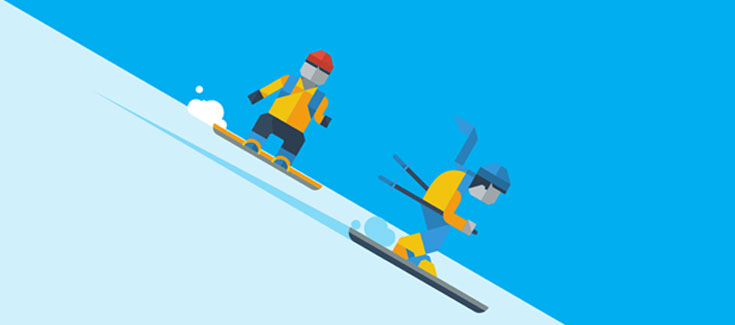Safely Skiing the Slopes

Originally Posted on March 29, 2018
Now that California ski season is finally making an appearance, physical therapists are anticipating the usual increase in orthopedic injuries that come along with it. Patients come in with knee injuries, ankle pain, and sometimes even head and neck problems after a long weekend on the mountain. So, how can you increase your safety and keep having fun? A few simple precautionary measures can help keep you safe and your body feeling good while you enjoy the great outdoors.
- Before the season even starts, begin thinking about a stretching and strengthening routine if you anticipate being up on the slopes a few times in the season. Starting to address quad, core, glute and arm strength can give you more control when skiing and help to stave off muscle soreness from returning to an activity you haven’t performed since last year. Being more flexible can help prevent muscle damage from pulling or straining tight muscles.
- Once you get there, look at a resort map and make a plan for the day. Even if you are an experienced skier, chances are you haven’t been in a while, so plan on starting out on runs that are below your skill level and then work your way up. On an easier run you can practice your turns and get a sense of what your body feels like. You can always advance to a more difficult run, but once you are at the top of the lift, there is only one way down!
- Ready to hit the lift line? Warm up first! It’s cold, your body is cold and stiff from getting up at the crack of dawn, so do it a favor and walk around a bit. Perform some of the stretches that you’ve been working on in the previous month. Your body needs to warm up before it can perform in the way that you expect it to.
- Finally, stay hydrated and wear the appropriate safety gear for your skill level. You may not feel thirsty, but you will be sweating as you exert yourself. Your muscles will perform better if they remain hydrated. Wear a helmet and other safety gear if you need it. Collisions with snow covered objects, fellow skiers, or trees/poles can all increase your risk of head and neck injury.
Physical therapists and wellness providers can help you lay out a plan to prepare for the season. In California our ski season can come well after Christmas, so there is usually ample time to prepare. Even if you only plan on a few weekends during the season, getting your muscles strong and stable can help you make the most out of those trips. Wall sits, squats, crab-walks, and lunges can all help tone your glutes and quads. Piriformis stretching, hamstring stretching and hip mobility exercises can keep your muscles limber and more responsive. Finally, core strengthening such as planks, dead bugs, and seated oblique rotations can help keep you stable and in control when turning. Have questions? Give us a call and we can set up a time to make a plan with you! Be safe and have fun!
We are here to help. If you feel you need professional help to improve your alignment, posture and help prevent further or future injury please don’t hesitate to contact us (925) 284-6150.
Written by Kathryn Cook, Physical Therapist Assistant at Lafayette Physical Therapy, Inc.
Arranged and Edited by Zack Krumland, BSBA, PR & Marketing Coordinator
Disclaimer
This article is intended as general health information and is not intended to provide individual specific medical advice, professional diagnosis, opinion, treatment or services to you or any other individual. Please consult your doctor or a medical professional before starting or changing a health, fitness, or nutrition program.

